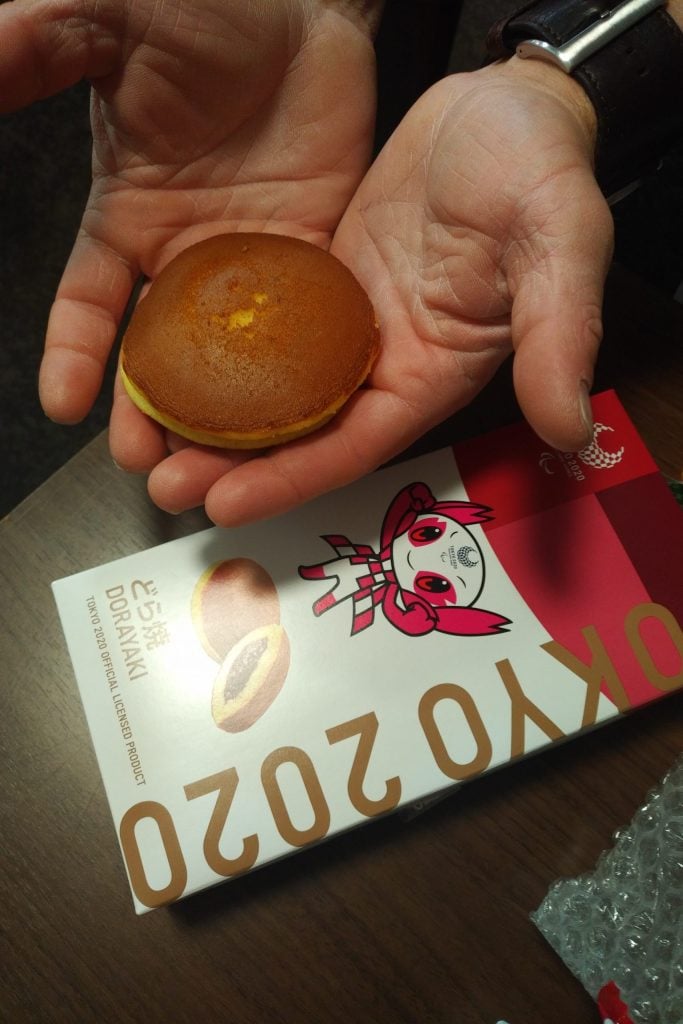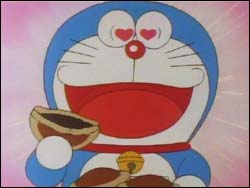During our stay in Tokyo, we didn’t taste many sweets, even though the cuisine of the rising sun is rich in them… in restaurants, there is no “dessert” on the menu; most sweets are found at street stalls or packaged in stores.
Among the few tasted was the dorayaki, at the airport, in a package dedicated to the upcoming Tokyo 2020 Olympic Games.
The dorayaki (どら?) is a type of Japanese sweet made of two pancakes, formed from kasutera (a sponge cake-like dough), and filled in the center with anko, a sweet reddish paste made from azuki beans, a filling in many other Japanese sweets.
Originally, the dorayaki had only one layer; the current two-layer form was invented in 1914.
In Japanese, dora means “gong,” and probably its shape similar to that of the musical instrument gave rise to the name of the sweet.
Legend has it that a samurai named Benkei forgot his gong at a farmer’s house where he was hiding, and the farmer used it to make the first dorayaki, hence the name.
Although the original filling recipe includes anko, there are numerous variations, such as chestnut cream or chocolate.

- Difficulty: Easy
- Cost: Affordable
- Rest time: 30 Minutes
- Preparation time: 10 Minutes
- Portions: 6 Dorayaki
- Cooking methods: Stovetop
- Cuisine: Japanese
Instructions
Break the eggs and put them in a bowl with the sugar, mirin and honey. Vigorously mix with a whisk until you get a light, fluffy, and frothy mixture.
Add the sifted flour and baking powder and blend the ingredients avoiding the formation of lumps.
Cover the bowl with cling film and refrigerate the mixture to rest for 30 minutes.
Remove the mixture from the refrigerator and add the water: you should obtain a soft but not too liquid mixture.
Heat a non-stick pan and lightly grease it with vegetable oil.
Using a ladle, pour some mixture in the center of the pan to get pancake-like circles about 3 to 4 inches in diameter.
When bubbles start to appear on the surface of the mixture, flip the dorayaki to the other side with the help of a spatula. Cook until golden brown on both sides.
If your dorayaki are not perfectly round, you can shape them better once cooked.
Take two halves, fill with the anko filling, and gently press the edges.

The dorayaki are known to be the favorite dish of the robot-cat Doraemon, the protagonist of the homonymous animated series, but unlike what it might seem, the name “Doraemon” does not derive from dorayaki but from noraneko (“stray cat” in Japanese).
VIDEO RECIPE:
AFFILIATE LINK #ADV
DORAEMON, Cup + Spoon + Lid 19.56 €
DORAEMON, Cup + Spoon + Lid 19.56 €
In the book “Le ricette della signora Tokue” the dorayaki are the protagonists of the story.
What is anko?
Anko (餡子) or An, is a sweet paste made from red azuki beans, an essential ingredient in many traditional Japanese sweets.
It is made with simple ingredients: azuki beans, water, and sugar. There are two main varieties of anko: koshian (smooth, with mashed beans) and tsubuan (chunky, with bean pieces).
The second version is less processed, retaining the bean skins, while the first is more processed, with a smoother and creamier texture.
Among the different types of wagashi, the best known are mochi, daifuku, manjū, dango, yōkan, dorayaki.
The ingredients at the base of these sweets are all natural, extracted from plants: cane sugar, azuki beans, glutinous rice flour, agar-agar, used as a natural gelling agent, extracted from seaweed.
Wagashi refers to traditional Japanese confectionery, which are sweets usually served during the tea ceremony (but not only).

